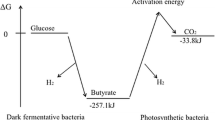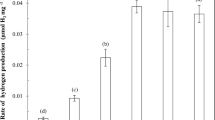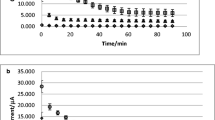Summary
A blue-green algae, Anabaena N-7363, was immobilized in 2% agar gel. The hydrogen productivity of the immobilized algae was three times higher than that of free algae. The maximum hydrogen production rate by the immobilized blue-green algae was 0.52 μ moles h−1 g−1 (of wet gel) in the medium without nitrogen sources under illumination (10,000 lux). The oxygen evolved was then removed by a reactor containing aerobic bacteria. A photo-current of 15–20 mA was continuously produced for 7 days by the photochemical fuel cell system consisting of the immobilized Anabaena reactor, the oxygen-removing reactor and the hydrogen-oxygen fuel cell. The conversion ratio of hydrogen to current was from 80% to 100%.
Similar content being viewed by others
References
Aizawa M, Suzuki N, Takahashi F, Suzuki S (1977) Photoelectrochemical reaction of chlorophyll immobilized with liquid crystal on metal surface. J Solid-Phase Biochem 2:111–121
Asada Y, Tonomura K, Nakayama O (1979) Hydrogen evolution by an isolated strain of Anabaena. J Ferment Technol 57:280–286
Benemann JR, Berenson JA, Kaplan NO, Kamen MD (1973) Hydrogen evolution by a chloroplast-ferredoxin-hydrogenase system. Proc Natl Acad Sci USA 70:2317–2320
Benemann JR, Weare NM (1974) Hydrogen evolution by nitrogenfixing Anabaena cylindrica cultures. Science 184:174–175
Berk RS, Canfield JH (1964) Bioelectrochemical energy conversion. Appl Microbiol 12:10–12
Fong FK, Winograd N (1976) In vitro solar conversion after the primary light reaction in photosynthesis. Reversible photogalvanic effects of chlorophyll-quinhydrone half-cell reactions. J Am Chem Soc 98:2287–2289
Karube I, Matsunaga T, Tsuru S, Suzuki S (1977) Biochemical fuel cell utilizing immobilized cells of Clostridium butyricum. Biotechnol Bioeng 19:1727–1737
Ochiai H, Shibata H, Sawa Y, Katoh T (1980) “Living electrode” as a long-lived photoconverter for biophotolysis of water. Proc Natl Acad Sci USA 77:2442–2444
Rohrback GH, Scott WR, Canfield JH (1962) Biochemical fuel cell. Proceedings of the 16th Annual Power Sources Conference, 18–21
Suzuki S, Karube I, Matsunaga T (1978) Application of biochemical fuel cell to waste waters. Biotechnol Bioeng Symp 8:501–511
Suzuki S, Karube I, Matsunaga T, Kuriyama S, Suzuki N, Shirogami T, Takamura T (1980) Biochemical energy conversion using immobilized whole cells of Clostridium butyricum. Biochimie 62:353–358
Takahashi F, Kikuchi R (1976) Photoelectrolysis using chlorophyll electrodes. Biochim Biophys Acta 430:490–500
Author information
Authors and Affiliations
Rights and permissions
About this article
Cite this article
Kayano, H., Karube, I., Matsunaga, T. et al. A photochemical fuel cell system using Anabaena N-7363. European J. Appl. Microbiol. Biotechnol. 12, 1–5 (1981). https://doi.org/10.1007/BF00508110
Received:
Issue Date:
DOI: https://doi.org/10.1007/BF00508110




